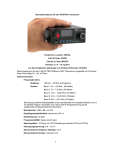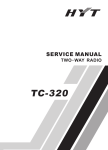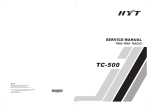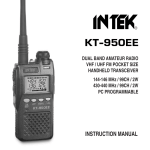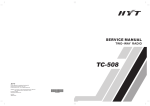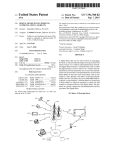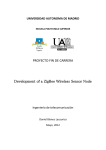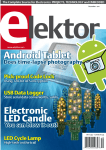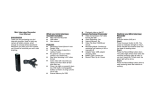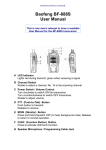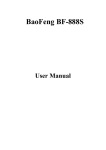Download UV-3R FAQ - Wouxun.us
Transcript
UV-3R FAQ Version 2011-12-22 An amazing user community collaboration project. UV-3R FAQ. 4th version (2011.12.22) 1 Table of Contents VHF SECOND HARMONIC PROBLEM.......................................................................................4 QUICK TROUBLESHOOTING.....................................................................................................5 GENERAL.................................................................................................................................... 6 What is the Baofeng UV-3R?..................................................................................................6 What is the Baofeng UV-3R Mark II?.......................................................................................6 How much does the UV-3R cost?...........................................................................................6 Where can I buy the UV-3R and accessories?........................................................................7 What warranty is offered?........................................................................................................7 How long does it take to get it (from Hong Kong)?..................................................................7 What is in the UV-3R box?......................................................................................................8 What are the differences between UV-3R, UV-100 and UV-200?...........................................8 Are there clones/similar devices?............................................................................................8 12 vs 18 menu settings?!........................................................................................................8 How do I reset the radio to factory settings?...........................................................................9 Is there a display protective film?............................................................................................9 Are the coloured cases painted or mass-coloured within the plastic?......................................9 Is there a replacement type for the battery?............................................................................9 How long does it take to charge the battery?...........................................................................9 Battery care and charging.......................................................................................................9 ANTENNA.................................................................................................................................. 11 What is the antenna connector type?....................................................................................11 Which dual-band antenna can I buy?....................................................................................11 Is the SRH805 antenna any good?........................................................................................11 MEMORIES............................................................................................................................... 12 How do I manually program memories?................................................................................12 How does the programming software work?..........................................................................13 Programming does not work. Help!.......................................................................................14 Can I use the programming software without the radio?........................................................14 Software Install - Mark II Upgrade.........................................................................................15 How do I delete a memory channel?.....................................................................................15 How do I skip memories during scanning?............................................................................15 Does Dual-Watch work during scanning?..............................................................................15 How do I set alphanumeric tags to memories?......................................................................15 How do I get 99 memories?...................................................................................................16 Can I operate on AMSAT/LEO satellites?.............................................................................16 Can I operate cross-band?....................................................................................................17 Can I copy a memory to VFO?..............................................................................................17 Can I build my own programming cable?..............................................................................17 Where can I get programming software?...............................................................................17 What is the difference between UV-3R software and Chirp?.................................................18 UV-3R FAQ. 4th version (2011.12.22) 2 How do I program when using Linux?...................................................................................18 FEATURES................................................................................................................................ 20 How does the LED torch work?.............................................................................................20 What is the transmit frequency range?..................................................................................20 What is wide/narrow setting?.................................................................................................20 What does RelayM do?......................................................................................................... 20 What does the Save function do?..........................................................................................21 How can I do “reverse” on a repeater?..................................................................................21 How do I generate DTMF tones?..........................................................................................21 How do I set frequency scan limits?......................................................................................21 Squelch Settings................................................................................................................... 21 Can I use the UV-3R while the charger is connected?..........................................................21 Can I use the programming cable to remote control UV-3R?................................................22 Can I update the firmware with the programming cable?.......................................................22 Can I use Yaesu programming cables?.................................................................................22 FM radio reception gets interrupted with VHF/UHF signal.....................................................22 TIPS&TRICKS........................................................................................................................... 23 KNOWN PROBLEMS (and fixes), MODS..................................................................................24 The Usual Disclaimer............................................................................................................ 24 Low power on VHF “low” setting............................................................................................24 How to increase output power?.............................................................................................24 How to disassemble UV-3R?.................................................................................................24 VHF second harmonics.........................................................................................................25 Loud volume and 1750Hz access tone..................................................................................25 TX lock on VHF using the supplied earpiece.........................................................................26 On my UV-3R Mk.II I cannot change the UHF step-size........................................................26 My VHF/UHF receiver does not work....................................................................................26 My VHF/UHF transmitter does not work................................................................................27 What is the strong signal on 156 MHz?.................................................................................27 The FM radio does not work..................................................................................................27 Is there a software maintenance mode?................................................................................28 My UV-3R just completely reset itself. Why?.........................................................................28 Is it possible to change radio calibration settings with the provided software?......................28 Help! Display shows DDD.D25!.............................................................................................29 Technical Documentation......................................................................................................30 LICENSING ISSUES................................................................................................................. 31 Does use of these radios require a license?..........................................................................31 Is it legal to use these radios without a ham license if I never transmit?................................31 Can I use it as a FRS/GMRS radio?......................................................................................31 What about search and rescue operations?..........................................................................32 Can I carry one of these HTs for emergency use in the bush or in my bug out bag?.............32 FCC Certification................................................................................................................... 33 Can I use this radio on PMR446 (European equivalent of FRS)?..........................................33 CONTRIBUTORS...................................................................................................................... 35 UV-3R FAQ. 4th version (2011.12.22) 3 VHF SECOND HARMONIC PROBLEM All stock UV-3R and derivatives exhibit a non-acceptable level of second harmonic (that is “display frequency x 2”) when transmitting on VHF HAM band (144-146/148 MHz). Connecting a VHF resonant antenna may reduce the amount of energy radiated on the 2nd harmonic but still does not qualify the device for acceptable spurious emissions as required by regulators worldwide for HAM transmitters. Modifications to the output low pass filter have been well documented in the UV-3R Yahoo! group Files area, so the brave can modify the radio to reduce unwanted radiation. For owners in United States of America, stock UV-3R (MarkI and MarkII) are Part 90 approved, not Part 97. For owners in European Union, stock UV-3R comes with CE0678 certification (starting point for further information is http://ec.europa.eu/enterprise/sectors/rtte/documents/). UV-3R FAQ. 4th version (2011.12.22) 4 QUICK TROUBLESHOOTING Problem Quick solution In the FAQ? Programming software does not connect to the radio Push the cable harder into the radio Check the proper COM port has been selected (COM5 seems to work) TX lock on VHF It is a known problem when using high power on VHF with the supplied earpiece Yes Too low power on VHF low This is a known issue, not a fault. Yes How do I stop the siren/alarm? Press the PTT. VHF second harmonics? Most, if not all, UV-3R show a very high second harmonic when transmitting within the VHF HAM band. There is no quick solution other that not transmitting on VHF. UV-3R FAQ. 4th version (2011.12.22) Yes 5 GENERAL What is the Baofeng UV-3R? The Baofeng UV-3R is a compact(*) transceiver for the VHF and UHF amateur bands, as well as many of the public service bands. It uses a unique pair of microprocessor - one for the radio itself, and the other as a control computer: this makes it an SDR (Software Defined Radio). Further, being a low power unit (2 watts, more or less), it is able to use commonly available lithium ion batteries, such as are found in digital cameras. As a consequence it is very compact, easily fitting in a shirt or pants pocket. The transceiver is fully functional with CTCSS and DCS codes, offset, and shift settings for use to access repeaters. With the programming cable and software, it is possible to set the “splits” for use with amateur FM satellites. Further, the transceiver contains a listen-only FM receiver for the FM broadcast band on a dedicated chip. (*) The transceiver is 47x81x23 mm, and weights about 120g (radio with battery and antenna). That’s about the same size as a standard 20 cigarette pack, which non-smokers should also be familiar with. What is the Baofeng UV-3R Mark II? The UV-3R Mark II is a second release of “R” that appeared at the beginning of September 2011. The most obvious difference is a dual-frequency display and that it comes with a dualband antenna, for about 5 USD more. On 2011 September 20, the first user review has rolled in. See http://groups.yahoo.com/group/UV-3R/message/2095 and subsequent messages in the thread. Also a word of caution if using the programming cable: data format has changed from UV-3R and UV-3R MarkII. A new version of the programming software has been released, so make sure you are using the latest available program! How much does the UV-3R cost? As of September 2011 the radio comes shipped from Hong Kong for 45 USD. Local/national sources may be selling it too, at a higher price but with added customer protection measures and/or accessories (read below). UV-3R FAQ. 4th version (2011.12.22) 6 Where can I buy the UV-3R and accessories? (IMPORTANT: no ADs of your shop here!) At the time being, there are several sources, the cheapest being the known auction website. As of September 2011 the radio comes shipped from Hong Kong for 45 USD. There are combined packages with a dual-band antenna, a car charger, a second battery, USB programming cable … which cost a little bit more but will save you on future shipping costs. Orders from Hong Kong can be shipped with DHL or other express courier, which means the box hits your door in a few days, at the costs of few more bucks. In many countries local HAM radio shops are selling the UV-3R as well, usually offering better warranty options, faster shipping and no customs fees. Check your local/national sources UV3R price and availability. Also, Ham radio shops are now selling accessories such as a spare battery, the USB programming cable, and coloured cases to replace a damaged one or for a change of colour! Google Plastic Shells for Baofeng UV-3R You may want to order it with the USB programming cable. The software is a free download. What warranty is offered? (IMPORTANT: no ADs of your shop here!) If buying directly from Hong Kong you should get a repair/replacement upon return of the faulty item. You have to pay for the shipping cost for returning the faulty item to HK. Check the rules with the seller before buying! If the UV-3R has been bought new from a local/national source, check with the seller for his warranty policy in advance. Warranty rules depend on your country and shop, so it is impossible to list them here. How long does it take to get it (from Hong Kong)? The answer to this question depends on too many factors. If not ordered with an express courier and the UV-3R is in stock at the HK seller, it will probably leave Far East within a week from payment. So far they have been shipped as registered letter, so you can track it on Hong Kong Post website and then on your country’s Post website. Depending on your country’s customs, the parcel might get stuck there, so the total travel time can be anywhere between 2 and 6 weeks. Certain countries may expect more delay. All Far East sellers are well aware of shipping times and usually mention it on their pages. UV-3R FAQ. 4th version (2011.12.22) 7 If you are in a hurry, then pay for express courier delivery (DHL and such). You may group with local HAMs to split the extra cost. DHL usually does apply VAT and import duties, so consider taking advantage of a group buy. What is in the UV-3R box? You usually get (copied from an auction description): ● ● ● ● ● ● ● ● 1 x BAOFENG UV-3R (VHF136-174 / UHF 400-470 MHz Dual Band) 1 x 3.7 V Li-ion Battery 2 x Antenna (one for VHF and one for UHF), new versions have a dual band antenna 1 x Belt Clip 1 x English Manual 1 x Charger with Cable (with plug for your Country) 1 x PTT Earpiece (see note about problem with this with RF pickup) 1 x Wrist/neck strap Additional items can be added in case of combined orders (a dual-band antenna, second battery, USB programming cable, etc. ). What are the differences between UV-3R, UV-100 and UV-200? The three models are said to be electrically identical, just with a different exterior look and external port. UV-100 and UV-200 share a compatible with speaker-mic (409shop item 41-75B), UV-3R does not. NOTE: speaker mike claims compatibility with all three. Are there clones/similar devices? UV-100 and UV-200 are said to be almost identical to UV-3R (see previous question). UV-3R can also be found under brand names other than Baofeng, like Vero, Magiksun, … The UV-4X appears to be the same unit as the UV-3R Mk II with a name change for specific marketing purposes or vendors. 12 vs 18 menu settings?! First UV-3R transceivers had only 12 settings accessible through the keypad menu. Settings 1318 could be changed only via the programming software. Sometime in Spring 2011 UV-3Rs were produced with new firmware that gives access to all 18 settings via the onboard menu. UV-3R FAQ. 4th version (2011.12.22) 8 How do I reset the radio to factory settings? Hold down the VHF/UHF button while powering up the radio. Is there a display protective film? Yes, it is there: the display comes with a protective film on it. It has been cut to the exact shape of the display, so it is hard to notice (and to peel-off on its own). Are the coloured cases painted or mass-coloured within the plastic? All covers except the camo are mass-coloured and not painted. The camouflaged type is a green shell, overpainted with olive and black paint with gaps between those two to reveal the green shell too, which produces a tri-tone camo. After tests the paint was found to be quite resilient to damage. Thanks to Nuno for the tests and the following photos: http://groups.yahoo.com/group/UV-3R/photos/album/297298078/pic/list Is there a replacement type for the battery? The battery pack is a standard NP60 type which is used in many digital cameras of Sony, Nikon and Ricoh. NP60 is available from many spare part dealers but check the indicated capacity before purchasing. The stock pack has 1550 mAh (18 menu version) capacity. Note that the Casio NP60 battery is not the same type.... How long does it take to charge the battery? Allow between four and five hours. The LED on the charger will change from red to green when the battery is fully charged. You can disconnect the charger before the battery is fully charged and use the rig without detriment to the battery. However, the first charge must be a full one. Battery care and charging There is a charging controller chip inside the radio but if you charge a battery in the base there is no controller and it then relies solely on the safety chip in the battery. The wall power adapters with color changing LEDs (green/red) sense current flow and change colors when the internal battery safety chip shuts down and do not actually have a charge controller. Some cheap replacement batteries may not have this chip. Some users have installed a MAX1811 charge control IC in the charging base. See the picture section and search the messages for MAX1811. In Europe maybe it’s cheaper to use MCP73831. UV-3R FAQ. 4th version (2011.12.22) 9 The battery used is a Li-ion type. For longevity of this type of battery it should be recharged when the battery level has fallen to just one third full i.e. one little bar left in the battery icon. Li-ion batteries do not like being fully discharged before charging and their lifespan will be reduced. Also, they do not like being left in a fully charged state in hot conditions. See Battery University for full details. UV-3R FAQ. 4th version (2011.12.22) 10 ANTENNA What is the antenna connector type? The UV-3R mounts a SMA-Female antenna connector, therefore you need to buy SMA-Male terminated antennas. You may also get BNC(f)-to-SMA(m) adapters to use your existing whips or cables. A PL-to-SMA works too, but it might put too much strain on the antenna connector. Some of the adapters are a tight fit, and it may be necessary to remove a small amount from the case near the LED with a hobby knife to get firm seating. Which dual-band antenna can I buy? Not all SMA-male antennas fit on the UV-3R: if their base is too large it will get stuck against the LED. The new ones (Mark II) come with a dual band antenna. Favorite after-market antennas are the SMA-male Nagoya NA-666 and NA-701 (most popular) from eBay. Some of the Comet and Diamond (USA) antennas work nicely as well. In the UK the Watson WHSM270 dual-band antenna has been found to work well. Sold packaged with the UV-3R is usually the A3SM-UV, which performs like the standard single-band antennas, or better. The issue is that some of the aftermarket antennas are fairly bulky, and can put a strain on the SMA connector. If you plan on connecting your Baofeng UV-3R to an external antenna, use one of the SMA to UHF or BNC jumper cables. Some suggested brand models: MFJ-1716S, MFJ-1713S, Diamond SRH815, Diamond SRH519, Maldol MH-511, Comet SMA503. Is the SRH805 antenna any good? The short answer is: NO. The long answer is that an antenna needs to be long to perform (in the case of UV-3R, close to a quarter of wave at the operating frequency), and this dual-band antenna is just 4.5cm tall. Beware of Fake SRH805 on eBay. They are even worse but see the picture section for a mod. UV-3R FAQ. 4th version (2011.12.22) 11 MEMORIES How do I manually program memories? First, get a list of the repeaters or simplex frequencies you wish to program into the UV-3R. You will need: 1. 2. 3. 4. Receive frequency for the repeater. PL tone, if needed. Omit for the simplex frequencies, of course. Offset direction - plus or minus. Zero for simplex. Shift value for transmit. Usually 600 kHz for 2 meters, 1.6 or 5 MHz for 70 cm. Make sure you are in VFO mode for 2 meters. Display should show NO channel number. In case, press/hold U/V key long enough to get there -- it will cycle through memory mode, UHF, VHF. To set the receive frequency, lift knob and rotate to get desired value. For 1 MHz steps (saves some time!), press and release function key, then rotate knob by 1 MHz increments. Do that same sequence again to get back into normal frequency setting mode. From here on, you need to set some menu items. The sequence for setting menu items is: ● Press Menu key. ● Rotate knob to desired menu item. ● Press U/V key to select that menu for alteration. ● Rotate knob to desired value. ● Press the PTT button to lock in the desired value. All menu items are set up this way. You may need to set the step value to 5 or 10 kHz, as the default is 12.5 kHz (12.5 kHz is the standard in IARU Region 1, that is Europe and Africa). There is a menu item for this. Select the desired PL tone from the TX tone menu. See the above sequence for setting up a menu selection. No PL tone is required for simplex channels. Set the transmit offset to 600 kHz, 1.6 or 5 MHz, as appropriate. Check your repeater directory for non-standard offsets. For 1 MHz steps you can use the Function tip described above. Set shift to "+", or "-" as appropriate. For simplex, the value is zero. UV-3R FAQ. 4th version (2011.12.22) 12 Now, test your settings. Pressing PTT should bring up your repeater. If not, check you settings. Just the receive frequency should be enough to hear your repeater. If you have another HT properly programmed, use that to key up the repeater for testing. I know, "kechunking" the repeater is bad manners, but.... If all is well, then store your setup in memory. Press F/A button on side, then U/V. Rotate knob to desired channel (you should have made a list), press U/V again to store the channel. Repeat for all other channels. If the PL tone, shift, or offset values are the same, you don't need to change them. This is why a list is useful. Keep a copy of the channel list with your HT, as there are no channel labels with the Baofeng, such as are found with the Wouxun and other HTs. How does the programming software work? First, get a list of the repeaters or simplex frequencies you wish to program into the Baofeng. In addition, you will need: ● A programming cable - USB connector on one end, the four-conductor plug on the other end. Yaesu programming cords will not work, as the connections are different. ● Programming software for the Baofeng. Download it from various sites. You will also need the driver software for your cable. You also need the information to enter into the program: ● Receive frequency for the repeater. ● PL tone, if needed. Omit for the simplex frequencies, of course. ● Offset direction - plus or minus. Zero for simplex. ● Shift value for transmit. Usually 600 kHz for 2 meters, 1.6 or 5 MHz for 70 cm. You then add or subtract this from the receive frequency, as appropriate. No shift is needed for simplex channels. First plug the USB connector into your computer. We are running Windows, of course. Your computer should detect the connector. If it asks for the driver software, set to the location where you have downloaded the driver software and install the driver software, as prompted. This will only need to be done once. Open up the computer system settings and find out which COM port has been assigned to the USB connector. Make a note of this. In the future, save yourself some trouble and always plug the USB connector into the same jack on the computer. Now, plug the four pin connector into the microphone jack on the Baofeng HT, and turn it on. Bring up the Baofeng programming software. Set the port drop-down to the value you found before. Clicking on a previously saved file won’t work. You have to open the file from within the control program. UV-3R FAQ. 4th version (2011.12.22) 13 Now, you are ready to program your Baofeng. Key in, line at a time, the receive, transmit, transmit tone (if needed), power (high, usually), and wide/narrow - wide setting. You will not need the receive tone, unless you have a repeater that uses tone controlled squelch. The option functions at the top are self-explanatory. The "Priority Channel" is the equivalent of a "dual watch" on most other HTs. If you want this feature, set that box to the desired channel number. The time-out-timer (TOT) should be set to something like 120 seconds. The VOX should be off, unless you like VOX. A squelch level of 2 or 3 usually works well. For LEO satellites, set this to zero. The frequency range should be set to V+UHF1. Save the file you have created with a convenient name for future use. The "Device Write" option writes to your HT. If you already have something stored in your HT, do a "Device Read" and save this before you do the "Device Write." It is convenient to have a number of different memory files for such things as locations you regularly visit, weather channels (NOAA in the USA), LEO satellites, or public service monitoring frequencies (if allowed). When you are done, exit the program and disconnect the cable from the computer and the HT. Please turn the radio off before inserting or removing the programming cable and save yourself the possibility of doing some harm to them. Once basic programming is done with Baofeng software, then the program called CHIRP works better. The main difference is Chirp does not have basic setup or config options, but is easier to use since it has copy/paste and multiple setups with tabs as well as importing data from various sources. Also, Chirp allows just setting the offset, not having to enter the separate transmit frequency. Even copying a bank of 2 meter and 70 cm freqs from a Chirps supported scanner works for monitoring, but that does not give the offsets for transmitting to repeaters. Programming does not work. Help! Do a system reset. Set up PL tone, offset, shift, and power level. Set frequency. Press F/S, then VHF/UHF to store in memory. Rotate knob first, if you don’t like the default channel. It is easier to use the programming cable and software in the event that you have more than a few channels to program. In this way, you can have different sets of channels for the areas to which you travel. Can I use the programming software without the radio? UV-3R FAQ. 4th version (2011.12.22) 14 So, you are waiting for your “R” and programming cable to hit your doormat but you have free time to prepare the memory file? No worries, install the correct software package on your computer, type in all your memories and save to a local file. Once the radio+cable arrives, install proper drivers (for the cable), load the saved .dat or .3r file and upload it to the radio. In other words: you don’t need the UV-3R to play with the programming software. It should also be noted that the “Chirp” software will allow you to transfer most of your settings from most other HTs that you own to the Baofeng. Software Install - Mark II Upgrade See the procedure described further below on how to fix the DDD.D25 problem. How do I delete a memory channel? Either over write it with a different channel, or use the programming software to clear the channel. How do I skip memories during scanning? See the Tips&Tricks section. Does Dual-Watch work during scanning? Dual watch is a misnomer. If you program a “priority” channel with the software, during scanning, this channel will be checked. The “dual watch” feature documented only works when in VFO mode, checking the other VFO. For example, if you are listening on VHF, it will check your UHF VFO periodically. How do I set alphanumeric tags to memories? As of September 2011AD neither MarkI nor MarkII support alphanumeric tags on memories, even though the latest programming software shows a column for tagging. From message #2801 (http://groups.yahoo.com/group/UV-3R/message/2801): with the Mark 2 UV3R, you can change the software (1.08 or above) to allow the entry of alpha tags (names) against the frequency. Look in C:\Program Files\UV3R\settings.ini (or the folder where you installed the software to) and change the following line: name=0 UV-3R FAQ. 4th version (2011.12.22) 15 to name=1 When you reload the UV3R software you can enter the name of the channel (4 characters only) in the last column. The bad news is that it's not yet clear how we should enable the channel name (alpha tag) display on the radio itself; NB: the change in settings.ini file must be done when the software is closed. At the time being nobody knows if alpha tags will come in a future UV-3R version. But it is useful to remember what that freq is for while in the programming file. How do I get 99 memories? There are actually 100 memories. Memory 100 appears to be the “Emergency” channel. Programming through the keypad/selector knob only gets you locations 1 through 99. The radio only displays the channels that have been programmed. The software lets you see all 99 channels as you edit them. If your brand new UV-3R has pre-programmed memories and you cannot get to program beyond location #20 (from the radio keypad), do a full reset before you begin storing your frequencies: it will clear all memories too. Can I operate on AMSAT/LEO satellites? Yes, but you need the programming cable to program memories. Setting crossband memories is not possible from keyboard. You need to use 6 memories per satellite because of uplink/downlink doppler effect. Memory programming example for AO-51 secondary repeater (we do not consider the uplink effect): Memory # TX RX 1 145.880 435.160 2 145.880 435.155 3 145.880 435.150 4 145.880 435.145 5 145.880 435.140 UV-3R FAQ. 4th version (2011.12.22) 16 During a pass change the receiver frequency as the rx signal shifts out of the channel: AOS mem 1 -> mem 2 -> TCA (CENTER) mem 3 -> mem 4 -> mem 5 LOS The currently active satellites: AO-51 (end of life! Enjoy while you can!), AO-27, SO-50 When operating through satellites please turn the squelch OFF !! More info about operating satellites with a HT can be found on: http://www.amsat.org/amsatnew/echo/EchoHT.php Can I operate cross-band? Yes, it is possible! Use the programming software to record a VHF TX and a UHF RX frequency (or the other way around). Unfortunately this configuration cannot be done via the radio keypad. Can I copy a memory to VFO? No. Can I build my own programming cable? Sure, see the Files section (http://groups.yahoo.com/group/UV-3R/files/) for a couple of ideas. If you take into account time and components it is probably cheaper to buy a commercial cable right away. Where can I get programming software? There are a few different URL’s listed in the Messages section, and the direct Vero Telecom (manufacturer) link is http://www.verotelecom.com/download.htm for the latest Windows version, which is v1.10 as of Dec 2011 for the Mk-II versions. Please see the Files/Software folder for earlier versions or those for Mk-I radios. The preferred software for updating the channel memory is Chirp, available from the program originators site http://chirp.danplanet.com/ . There are Windows, Mac (using KK7DS Python runtime) and two ‘flavors’ of Linux versions (Fedora, Ubuntu) available for download. Drivers for the Prolific USB chip used in many programming cables can also be found in the Files/Software folder. The small CD that comes with the USB programming cable may or may not be the newest version, or even be readable by your own computer. Note that the newest versions may not work (on Windows XP at least) for you, many have found that older driver UV-3R FAQ. 4th version (2011.12.22) 17 versions are required for the USB programming cable to operate. The older driver version 4.0.100 may be required if you have problems. Prolific website http://www.prolific.com.tw/eng/downloads.asp?ID=31 has many versions for download. What is the difference between UV-3R software and Chirp? A comparison of these two programs finds: Chirp programs each memory independently including - Freq, Tone mode, tone, DTCS code, mode, duplex (+ - duplex shift), offset, wide/narrow fm, power – but does not do the basic set-up programming. Baofeng software UV-[nn] (where [nn] = 3R or X4) has these although listed differently such as duplex/offset as separate entries for rx/tx freq sets. In addition UV-nn includes setting the basic setup items like Freq Range, scan setups, vco setup for both UHF and VHF vco's (rx freq, tx freq, encode, decode, power, fm wide/narrow, VCO step), squelch, VOX, ToT, channel mode (vco or memory mode), backlite setting, key tone, busy lock, and save function. These additional options in UV-[nn] are downloaded and saved/uploaded in Chirp, but not independently settable. They must be manually entered each time they need changing. Maybe that can be changed in future versions? UV-[nn] is far more comprehensive and useful for initial setup whereas Chirp is easier to use (copy and paste!) and far more flexible for general updating those 99 channels. USB drivers are available for most chipsets used in USB cables for Unix/Linux operating systems if not already a part of the operating system. How do I program when using Linux? I'm using XUBUNTU 11.10 with CHIRP installed through Ubuntu Software Center after executing the instructions over here: https://launchpad.net/~ubuntu-hams-updates/+archive/ppa I also use the Baofeng 1.09 software for Windows on top of WINE, the windows emulator in XUBUNTU. For the radio I have a USB-programming cable. For CHIRP I use /dev/ttyUSB0, but WINE does not support USB drivers. The cable however is recognized as a serial device and then all you need is a symbolic link between the UV-3R FAQ. 4th version (2011.12.22) 18 com port set in the Windows Baofeng program, e.g. com1 and /dev/ttyUSB0 and that must be in the folder ~/.wine/dosdevices This will work: ln -s /dev/ttyUSB0 ~/.wine/dosdevices/com1 [from message number 3739] For more information on WINE for Linux please see this link; http://www.reallylinux.com/docs/toptip4.shtml Ubuntu and other versions (or “flavors”) of Linux should have the drivers for the programming cable already, but not all do. For more information or to problem solve, please see Linux groups for your “flavor” (Red Hat, Fedora, Ubuntu, etc) for further assistance. When using Chirp through Ubuntu, you will also need to get auto program updates (PPA) set up using this link; https://launchpad.net/~ubuntu-hams-updates/+archive/ppa UV-3R FAQ. 4th version (2011.12.22) 19 FEATURES How does the LED torch work? Press the L/R orange button on the left side to switch on and off the top cover LED. This control is also active when the RTX is switched off (but a battery is connected). What is the transmit frequency range? The UV-3R receives AND transmits on the whole VHF&UHF specified range (136-174 MHz, 400-470 MHz). It is not possible to restrict transmission to HAM allocations only, therefore this little radio might be illegal in your Country. The RX/TX range can be modified by UV-3R programming software to lesson the chance of illegal transmissions if required, but may not satisfy legal requirements. For more information on reprogramming band edges please see message number 2968. Also, the TX frequency can be set to within Ham bands as a safety margin but this does not permanently restrict TX to those Ham frequencies alone. What is wide/narrow setting? This setting controls RX bandwidth and FM deviation. These have been measured to be: TX, max deviation wide, +/- 4.8kHz TX, max deviation narrow, +/- 2.4kHz Apparent RX -6dB bandwidth wide +/- 8kHz Apparent RX -6dB bandwidth narrow +/- 4kHz Adjacent channel selectivity measured as ETS300-086 was 70dB wide and 58dB narrow. What does RelayM do? Apparently it delays the return-to-receive after transmitting. This should cut the roger beep on repeaters that add it automatically. See http://groups.yahoo.com/group/UV-3R/message/1921 for a possible answer. Note: some older models and manuals refer to “ElayM” instead of “RelayM”. UV-3R FAQ. 4th version (2011.12.22) 20 What does the Save function do? While the user’s manual says it reduces the transmitted power when the received signal is strong, that seems to be a wrong copy-and-paste from a Yaesu manual. Measurements have been made on the receive current consumption, and confirmed that the Save function switches off and on the RX circuitry. How can I do “reverse” on a repeater? You can not. UV-3R does not carry the “reverse” command. Instead you can write your repeater memories alternating normal and reverse. How do I generate DTMF tones? You can not. The radio chip is capable, but the firmware does not support it. How do I set frequency scan limits? You can not. UV-3R will scan the entire VHF or UHF band. As a workaround you can program memories with simplex channels (spaced 10 kHz in IARU region 2 - Americas - and 12.5 kHz in IARU region 1 - EU/Africa -) and run a memory scan instead. The third option is to set the band limits as per instructions in Message Number 2968, but that limits ALL frequency related programming. This is not an elegant option, a good used scanner works much better for this. Squelch Settings Settings 1, 2, 6, 7, 8 and 9 are all the same - they let through weak signals and a signal can reduce to nothing before the squelch closes. Settings 3, 4 and 5 are all the same and do not allow weak signals through. Setting 0 opens the squelch fully, as does pressing and holding the VOL button. Can I use the UV-3R while the charger is connected? Yes you can. But be aware that the charger is a switched-mode type, and this type always emanates RFI. The RFI in this case is so strong that a 5.9+ signal can sound like a 5.2 one. UV-3R FAQ. 4th version (2011.12.22) 21 Can I use the programming cable to remote control UV-3R? No. Only memories can be read and written with the programming cable. Can I update the firmware with the programming cable? No. Only memories can be read and written with the programming cable. Can I use Yaesu programming cables? No, as the pinout is different. FM radio reception gets interrupted with VHF/UHF signal This is a feature. To avoid it, set your radio to a fairly unused channel or set an unused CTCSS/DCS code before going to FM. However, if you like to monitor traffic on your local repeater while listening to the FM radio, just set it to your favorite repeater. Does Chirp software work with the UV-3R? Yes, this works with the UV-3R. CHIRP is a FREE cross-platform, cross-radio programming tool. It works on Windows and Linux (and MacOSX with a little work). It supports a growing list of radios across several manufacturers and allows transferring of memory contents between them. Mike N4MEP tells how: I used CHIRP to read all my stored memories from a Wuoxun KG-UV3DP, saved them as a CSV file. I then read from the Baofeng UV-3R to create the correct image file and imported the saved CSV file. Then finally I wrote all the memories to the radio. You can get more info and download it HERE UV-3R FAQ. 4th version (2011.12.22) 22 TIPS&TRICKS During scanning, if you turn the dial the direction of scanning can be changed “on the fly” from low-high to high-low channel numbers. When a stored frequency becomes a nuisance, switch the RX to an unused CTCSS/DCS code and it skips that channel in the scan. You can do a similar setup for scan groups. Kind of labor intensive but it keeps weak stations and interference from interrupting scans. UV-3R FAQ. 4th version (2011.12.22) 23 KNOWN PROBLEMS (and fixes), MODS The Usual Disclaimer Q&As mentioned in the following paragraphs may require an electrical modification of the UV3R. As with any other electric/electronic device, opening the radio or any associated accessory voids the warranty. If you decide to try procedures documented hereafter you do it at your own risk of damaging the UV-3R, your tools, your environment, yourself. Low power on VHF “low” setting. Many UV-3Rs users experience a very low power output on the VHF HAM band in “low” setting. It has been measured to be at around 100mW at 145 MHz instead of the advertised 1W. This behavior is normal and there is no hardware fix. How to increase output power? There are no known modifications to increase the output power. Besides, there would probably be too little heatsink to dissipate the excess heat (making it a good “pocket warmer”) and surrounding components and PCB traces might not be designed for the excess current drain (turning the UV-3R into a smoke signals transmitter). Let alone a much shorter battery life. Remember: one S-point is 6dB; doubling the power just adds 3dB to your output. So with an increase from 2W to 4W you would only gain half an S-unit. If you need more power: ● buy a more powerful transceiver ● buy an external power amplifier ● use a better antenna How to disassemble UV-3R? Taken from message #342 (http://groups.yahoo.com/group/UV-3R/message/342) by Clint:. - Set down a piece of cloth on the workbench to capture screws and prevent the front panel and display from being scratched. - Remove belt clip - Remove antenna - Remove battery cover and battery - Remove screw on the knob and pull off knob from the rotary encoder. - Remove orange silicone washer from around antenna connector. UV-3R FAQ. 4th version (2011.12.22) 24 - Remove the two screws in the battery compartment. Note if they differ from each other and which one went where! - Lift out the rubber flap that covers the DC and Mic/Speaker connection. - Lift the bottom of the radio out of the case very carefully. It should go straight up until it clears the case and at that point the portion with the PTT/alarm/light buttons on the side should clear the case. At this point, slide out the radio chassis from the top hole that has the knob. - Note that the speaker connects with springs to the circuit board. If they are bent noticeably, remember to (gently) straighten them before reassembly. - Remove the nut from the rotary encoder. - Remove the four screws holding the circuit board: There two near the lower-middle of the board and also two just above the display. - With the display face-up, there is a solder connection to the SMA connector near the connector itself on the circuit board. While gently lifting up on the bottom of the circuit board, apply heat. The center pin of the SMA connector should easily pop out when the solder is melted. Note that lead-free solder is used, so you'll have to turn up your temperature-controlled iron to a higher temperature. Once the board was removed, I alloyed the lead-free solder in the hole where the SMA connector was with "leaded" solder and removed it - a process that I did twice. With old-fashioned leaded solder, the working temperature was lower and the eutectic mixture was more favorable to working and then I cleaned the hole. VHF second harmonics. All UV-3Rs VHF transmitters exhibit a very strong second harmonic (145 * 2 = 290 MHz). A fix has been published in the Yahoo Group Files section and consists in adding a capacitor to the output low pass filter. Note that when using a VHF resonant antenna the effectively radiated power on the 2nd harmonic probably lies within required FCC/CE specs. Loud volume and 1750Hz access tone Many users are irritated by the volume difference between the ham bands, the FM broadcast radio, and the various beeps. While the two ham bands and the beeps are already pretty loud at the minimum volume setting, volume has to be increased for the FM broadcast radio. There are two possibilities: 1. increase the AF amp feedback circuit - this reduces the overall amplification and is only useful when the FM broadcast radio volume is less important. This mod is described in detail at <TBC>. R15 (100k) is decreased down to at least 33k, to provide stronger feedback and hence less total amplification (a 27k soldered across R15 brings the total resistance to 22k). 2. modify the balance of the audio being mixed, by reducing both the levels of the ham bands path and the beep audio path. For the ham bands path R13 (10k) may be UV-3R FAQ. 4th version (2011.12.22) 25 increased up to 27K or 33K. For the tone beeps path R10 (100K) can be replaced by 220K or greater. However, the 1750Hz tone, which is used for accessing repeaters, is sent via the loudspeaker and picked up by the microphone. If R10 is increased too much the level of this access tone sent by the mic to the repeater will be too low. The solution by DD5XL is to reduce R10 to 660k (2 x 330k), add a 100nf capacitor across the unused PCB pads of C47, and add a 220k resistor across the unused pads of R46. This now directly feeds the 1750Hz tone into the modulation input of the RDA1846 chip - an added benefit is that the 1750Hz tone is sent even with the earpiece plugged in. Note that the 1846 chip with the 4MHz master oscillator cannot deliver 1750Hz exactly, it's actually 1736Hz so some repeaters may baulk at this.... (GTP) TX lock on VHF using the supplied earpiece. This appears to be due to RF being picked up on the cord. Get one of the larger ferrite choke sleeves from Radio Shack or the equivalent in your country. Take two turns of the earpiece cord through the core right next to the plug. It isn’t pretty, but it works. Others have suggested a SMT bypass capacitor of about 100pF internally on the PTT line. On my UV-3R Mk.II I cannot change the UHF step-size With the UV-3R Mk.II trying to change the step-size from the menu in UHF mode does not work. The tuning step-size can only be set from the menu when in VHF mode. When the step-size is set in VHF mode that step-size is used on both VHF and UHF. My VHF/UHF receiver does not work. The only known (through the Yahoo Group mailing list) out-of-the-box problem on a VHF receiver was experienced by IK1ZYW on a UV-3R bought in July 2011. The problem has been traced down to a cold solder joint in the switching diodes. The problem has been fixed with a hot-air (re)soldering station which brought back the RTX to 100% full functionality. Procedure to identify cold solder joints: ● work on a non-conductive surface (wood and plastic are OK) ● identify, with another receiver, a constant signal source in the band you experience the fault ● leave the other receiver on the active frequency ● tune UV-3R to the frequency located few steps above ● make sure SQL/squelch is set to one UV-3R FAQ. 4th version (2011.12.22) 26 ● ● ● ● ● ● ● ● make sure no CTCSS/DCS are set switch UV-3R off open up the UV-3R as described elsewhere; solder about 10cm of wire in place of the antenna connector connect the earpiece connect the charger to UV-3R, the radio will power up gently lay the bare board on the flat, non-conductive, surface using a plastic needle gently press down components until the squelch opens Congratulations, you have successfully identified the fault. Now you need to fix it, but that requires an expert technician and specialized tools. My VHF/UHF transmitter does not work RF is generated by the SDR chip inside UV-3R. Then applied to a buffer stage and switched to a dedicated amplifying chain, one per band. Each amplifier is composed of a driver and a final. Can you hear your transmission on a nearby receiver? Is there a difference between high and low power? Do you get the expected power on the other band? If so, the SDR chip is working and the fault is in the amplifier chain. Could it be that there is a cold solder joint in the VHF/UHF transmitter chain? TBC What is the strong signal on 156 MHz? The carrier on 156.000 MHz (marine channel 0) is caused by the 6th harmonic of the internal 26 MHz oscillator. This oscillator is used to run the main radio SDR chip so there is no cure. Other spurious signals can be heard on UHF as well, every few MHz. Fortunately they all stay out of the HAM bands. The FM radio does not work Hold the orange button on the side for about 2 seconds to get into FM radio mode. When FM mode is attained “FM” will appear on the lower left side of the display. Hold it again for about 2 seconds to get back to UHF/VHF mode. The letters “FM” will disappear when you exit “FM” mode. You can store favorite FM stations just like you do for VHF/UHF memories. Scanning through the FM band for stations is like scanning in VHF/UHF. Don’t forget to connect an antenna to the UV-3R! UV-3R FAQ. 4th version (2011.12.22) 27 If no FM broadcast can be received, try the procedure described above for looking for cold solder joints. Is there a software maintenance mode? As of UV-3R sold until October 2011 (Mark I and Mark II) there is no software maintenance mode. If it is there, nobody has figured out how. My UV-3R just completely reset itself. Why? If the frequency on the display was outside the normal range, e.g. 133MHz, when the UV-3R was turned off, it will completely reset itself to the factory default when you turn it on. Heinrich DB9PU explains: The firmware checks the active frequency during the shutdown procedure and, if the frequency is outside the firmware range of allowed frequencies, an internal failure of the microprocessor is assumed and a hardware reset will be made. To avoid this: 1. before switching off choose a channel with a frequency in the range 136 to 174 or 400 to 470MHz 2. switch off. NB: in order to get into this condition you must have played with the configuration file of the UV3R PC software and recorder an “out-of-band” frequency. This is NOT a normal condition your RTX can get into, so you should not worry if you are not doing anything strange with the software. Is it possible to change radio calibration settings with the provided software? As of October 2011 it is not possible to change UV-3R calibration settings. From message #342 (http://groups.yahoo.com/group/UV-3R/message/342): I also (mostly) reverse-engineered the UV-3R memory map. Unlike previous work with the FT-817, I didn't have to write my own program as the UV-3R program includes a handy function that shows the EEPROM map *and* changes that have occurred if you modify a setting. Using a normal HEX editor program, it's easy to figure out where the header is and make "additional" changes if necessary although it's possible to make some changes that cause the PC program itself to crash when you load the memory map! The upshot of this is that there does not appear to be any obvious place in there where other parameters may be changed, such as the amount of audio deviation, PA bias (to effect setting of the High/Low power and, to an extent, the harmonic content.) UV-3R FAQ. 4th version (2011.12.22) 28 If such values the program or available with available that are are the can stored in nonvolatile memory, they are either hard-coded into located in EEPROM on the processor itself and aren't readily supplied program - unless there's a "Calibration menu" be brought up in the radio that I don't know about... From what I can tell, the ONLY on-board adjustment is frequency trimming: There's a small potentiometer that adjusts the VCXO tuning voltage - but I've not touched that since my UV-3R is just 300 Hz high on 70cm - hardly enough to worry about! Help! Display shows DDD.D25! This happens when a UV-3R Mark II is programmed with an old version of the programming software. Download the newest software version and try re-programming your UV-3R: it should return to normal operation. A solution from John WB1GCQ follows, posted on the UV-3R mailing list and reproduced here with his authorization. Here is what I did using the information provided by the Group. 1) If you have preciously installed the software for the UV-3R; delete it from the computer before you start this procedure for the Mark II. 2) Download from the Files Section the Mark II software. I also found this software on the 409shop site. Not sure if both are the same version. 3) Download the driver you require from the 409shop site. I downloaded the usb driver for Windows XP. I did this even though I had the original driver installed. The install will inform you if you have current driver or newer version available for install. In my case I installed the newer driver. 4) Plug usb cable into computer. Go to Device Manager.Click on Ports and determine Comm port assigned to Prolific usb to serial comm. Mine was Comm 6. 5) Run the UV-3R Mark II software from the shortcut on the Desktop. Click on Settings and select an available Comm port. In my case I selected Comm 6 and clicked Ok to close. 6) On the grid at top it indicates Freq Range. The range 136-174/400-470 is presently selected. Click on down arrow to right and another range 144-146/430-440 is shown. Click on this range so it is now selected. 7) At this point my grid filled in the Channel 1 with a rx Freq of 146.0000. UV-3R FAQ. 4th version (2011.12.22) 29 8) My display on the UV-3R had DDDD25 on upper and DDDD25 on lower line at this point. Its been that way for a week looking for a solution! 9) I clicked on Program on top line of grid and selected "Write to Radio". Got a dialogue box. Clicked on Ok and program began writing to radio. Upon completion the DDDD25 disappeared from the first and second lines of the display. My display now shows 146.0000 on first line and 440.0000 on second line. 10) I clicked on Program on top line of grid and selected "Read from Radio". Got dialogue box. Clicked on Ok and program began reading from radio. 11) Success! things are going back to normal! Clicked on Files on top of grid and save As. The Mark II sortware format is *.3R. Original software was *.dat. The original Baofeng Memory Files are still on the computer so I saved this file as UV-3RMarkIIinitialread.3R. 12) Back to the grid and the Freq Range. Click on down arrow and select 136-174/400-470. When I did this Channel 1 was filled in with a frequency of 136.0000. 13) Clicked on Program on top of grid and selected "Write to Radio". Got dialogue box. Clicked on Ok. and program began to write to radio. 14) Upon completion my display showed 136.0000 on first line and 400.0000 on second line. 15) Clicked on Program on top line of grid and selected "Read from Radio". Got dialogue box. Clicked on Ok and program began reading from radio. 16) Clicked on Files on top of grid and save As. The Mark II software format is *.3R. Original software was *.dat. The original Baofeng Memory Files are still on the computer so I saved this file as UV-3RMarkIIrevisedread.3R. Technical Documentation Schematics, semiconductor datasheets, etc. are available in the UV-3R Yahoo Groups mailing list file section. Documents submitted as part of the FCC Part 90 approval process, including test reports, are available on the FCC site (link below in licensing section). UV-3R FAQ. 4th version (2011.12.22) 30 LICENSING ISSUES Information provided here is informative and is not intended as legal advice. Note that some sellers (such as dealextreme) carry these radios with no mention of the licenses required to operate (or in some cases even posses them). Does use of these radios require a license? Yes. In most countries, an Amateur Radio (Ham Radio) license is required which usually requires payment of a fee and taking exams covering technical and regulatory competency. An exception (in the US) is making a legitimate distress call (but you could be fined if the FCC doesn’t consider your emergency serious enough). Fines for unlicensed operation start at $10,000 and go up. A license may or may not be valid outside the country it was issued in and the laws and allowed frequencies may vary by country. In some repressive countries, possession of radio communications equipment may be illegal. These devices allow tuning and transmitting outside the limits of the ham bands in the US and other countries, so a license does not permit you to transmit on every frequency they are capable of transmitting on. Is it legal to use these radios without a ham license if I never transmit? In many cases, no. In some US states it is illegal to operate (receive only) or even posses a scanner capable of receiving police bands in a vehicle or on your person (but fixed home operation is generally allowed); an exception is made for licensed hams. It is illegal to disclose information overheard on a scanner. It is illegal to use a scanner in the commission of a crime. It is illegal to listen in on cell phone transmissions; some cell phone systems use frequencies within the 450Mhz band which these radios can receive, though not in the US where this law applies. Laws outside the US are different. Can I use it as a FRS/GMRS radio? To do so is technically illegal; however, one is generally allowed to break rules concerning licensed operation to issue legitimate distress calls when life or property is in immanent danger provided you don’t interfere with other vital communications and lack other means of communication. Rules vary by country. Fines could be very stiff. UV-3R FAQ. 4th version (2011.12.22) 31 These units can operate on FRS/GMRS frequencies. They can probably be configured for FM devition within the allowed limits for these bands. FRS/GMRS radios are required to be FCC type accepted for FRS/GMRS use; these are not. FRS radios are prohibited from having detachable antennas (in order to prevent use of a high gain antenna). GMRS Radios are allowed to have detachable antennas. These radios have detachable antennas. Transmission on FRS frequencies is limited to 0.5W and 50W on FRS channels 1-7 and GMRS channels with a GMRS license ($85). These radios transmit more than 0.5W at FRS frequencies even on the low setting (unless hardware mods are used to make the low power mode meaningful). Channel memories may or may not allow enforcing low power mode on some channels. If handed to an unskilled user in FRS mode, what is there to prevent them from inadvertently setting the frequency outside the FRS band? These radios may be used to receive FRS/GPRS frequencies. If, in a life threatening emergency, you hear transmissions on FRS/GPRS frequencies from the SAR teams looking for you and lack other means of communication, it would be reasonable to respond. What about search and rescue operations? The FCC has gone after SAR operations (even ones which are part of government agencies) for routine use of non-type-accepted equipment even on frequencies which they had a specific license to operate on. Equipment which operates on commercial/government/police/fire/rescue bands (anything other than ham bands) must not only meet specifications but be type accepted by the FCC to meet those specifications. Technical requirements are more lax on the ham bands and ham equipment may not meet the requirements of other bands even when properly operated. People who are licensed hams and part of an SAR team licensed to operate on a specific frequency may carry a separate type accepted SAR transceiver in addition to their ham transceiver and only use their ham equipment on SAR band (with mods) in extreme circumstances. Letters of authorization from police or SAR coordinators, rather than the FCC, are not valid. http://www.sarinfo.bc.ca/Library/Communications/RADIO.coms Can I carry one of these HTs for emergency use in the bush or in my bug out bag? UV-3R FAQ. 4th version (2011.12.22) 32 Given the small size and low cost of these HTs, this is certainly worth considering as one of your emergency communications devices. In some jurisdictions, mere possession without a ham license may be illegal. And using them on ham bands without a ham license or on FRS/GPRS/fire/police/marine/aviation/SAR or any other non-ham bands, even with a valid operators license for those bands/frequencies is generally illegal except for the bare minimum of communications required in a life threatening communication when no other options are available. See the sections above for more details. Bear in mind that these are more or less limited to line of site communications. From high ground you may be able to reach a fairly distant repeater located on a mountain top. Standard rechargeable batteries (especially cheap imports) may be dead when you need them; battery holders for alkaline batteries (with longer shelf lives) are available. If you do not have a ham license, how are you going to legally test them to see if they work? These cheap models are less reliable than good ham equipment. Li-poly batteries may have self discharge rates of 1-5% per month. Self discharge rate increases dramatically with temperature. In addition, the annual permanent capacity loss increases dramatically with temperature. Permanent capacity loss is much faster when the battery is 100% charged vs 40% charged. At 60C and 100% charge, the battery permanently loses 40% of its capacity in 3 months. http://batteryuniversity.com/learn/article/how_to_prolong_lithium_based_batteries For more routine communications, you should have other devices which can be legally operated by all members of your party. FCC Certification The UV-3R (and trivial variants UV-100, UV-200) radio recently certification. (July 2011) passed FCC Documents submitted to the FCC for the Part 90 certification process: https://apps.fcc.gov/oetcf/eas/reports/ViewExhibitReport.cfm? mode=Exhibits&RequestTimeout=500&calledFromFrame=N&application_id=186528&fcc_id=\ %27ZP5BF-3R\%27 This may make newer versions of the radio, with the FCC sticker, legal for Land Mobile Radio Service. Can I use this radio on PMR446 (European equivalent of FRS)? UV-3R FAQ. 4th version (2011.12.22) 33 Not legally. The laws concerning PMR446 are very similar to those governing FRS (see above). They also specifically prohibit the use of transceivers which are also capable of operating on other services. UV-3R FAQ. 4th version (2011.12.22) 34 CONTRIBUTORS Paolo, IK1ZYW, Italy, JN35tc :-) Paul, W3FIS in “Slower Lower” Delaware, USA, FM28KL Lee, N9LO, Wisconsin USA, EN44VP Bert, DD5XL, Germany, JO41VX Horace, YO2LQL, Romania, KN05os Oliver, SWL 2220530, Germany, JN39LT David, G4TUP/9H3CU, United Kingdom, IO83MQ (GTP) Ondra, OK1CDJ, Czech Republic, JO70VA Mark, KI4BSZ, USA Bart Van Allen, KA7ZFD, Utah, USA UV-3R FAQ. 4th version (2011.12.22) 35



































